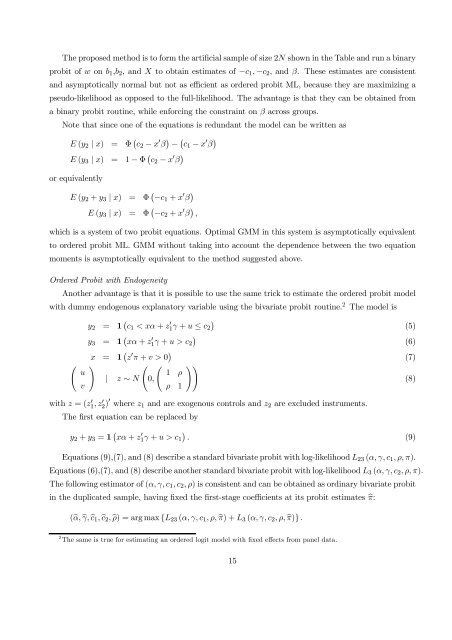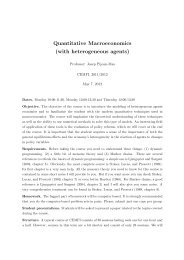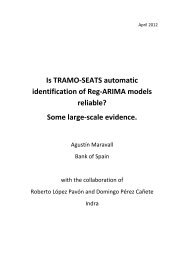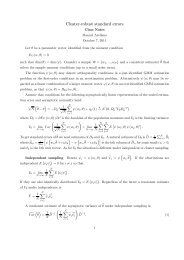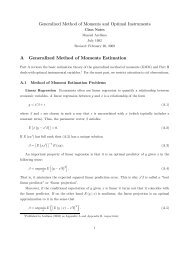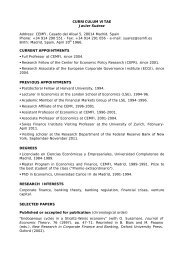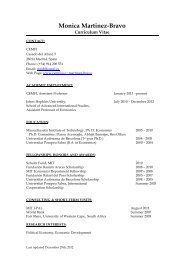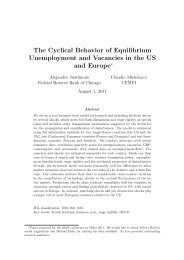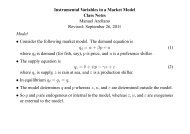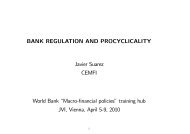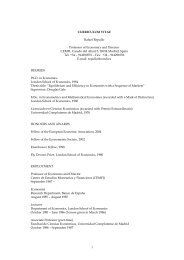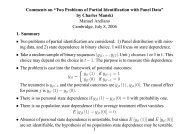Binary Models with Endogenous Explanatory Variables 1 ... - Cemfi
Binary Models with Endogenous Explanatory Variables 1 ... - Cemfi
Binary Models with Endogenous Explanatory Variables 1 ... - Cemfi
Create successful ePaper yourself
Turn your PDF publications into a flip-book with our unique Google optimized e-Paper software.
The proposed method is to form the artificial sample of size 2N shown in the Table and run a binary<br />
probit of w on b1,b2, andXto obtain estimates of −c1, −c2, and β. These estimates are consistent<br />
and asymptotically normal but not as efficient as ordered probit ML, because they are maximizing a<br />
pseudo-likelihood as opposed to the full-likelihood. The advantage is that they can be obtained from<br />
a binary probit routine, while enforcing the constraint on β across groups.<br />
Note that since one of the equations is redundant the model can be written as<br />
E (y2 | x) = Φ ¡ c2 − x 0 β ¢ − ¡ c1 − x 0 β ¢<br />
E (y3 | x) = 1−Φ ¡ c2 − x 0 β ¢<br />
or equivalently<br />
E (y2 + y3 | x) = Φ ¡ −c1 + x 0 β ¢<br />
E (y3 | x) = Φ ¡ −c2 + x 0 β ¢ ,<br />
which is a system of two probit equations. Optimal GMM in this system is asymptotically equivalent<br />
to ordered probit ML. GMM <strong>with</strong>out taking into account the dependence between the two equation<br />
moments is asymptotically equivalent to the method suggested above.<br />
Ordered Probit <strong>with</strong> Endogeneity<br />
Another advantage is that it is possible to use the same trick to estimate the ordered probit model<br />
<strong>with</strong> dummy endogenous explanatory variable using the bivariate probit routine. 2 The model is<br />
y2 = 1 ¡ c1 c2<br />
(6)<br />
x = 1 ¡ z 0 π + v>0 ¢<br />
(7)<br />
à !<br />
à à !!<br />
u<br />
1 ρ<br />
| z ∼ N 0,<br />
(8)<br />
v<br />
ρ 1<br />
<strong>with</strong> z =(z 0 1 ,z0 2 )0 where z1 and are exogenous controls and z2 are excluded instruments.<br />
The first equation can be replaced by<br />
y2 + y3 = 1 ¡ xα + z 0 ¢<br />
1γ + u>c1 . (9)<br />
Equations (9),(7), and (8) describe a standard bivariate probit <strong>with</strong> log-likelihood L23 (α, γ,c1, ρ, π).<br />
Equations (6),(7), and (8) describe another standard bivariate probit <strong>with</strong> log-likelihood L3 (α, γ,c2, ρ, π).<br />
The following estimator of (α, γ,c1,c2, ρ) is consistent and can be obtained as ordinary bivariate probit<br />
in the duplicated sample, having fixed the first-stage coefficients at its probit estimates bπ:<br />
(bα, bγ, bc1, bc2, bρ) = arg max {L23 (α, γ,c1, ρ, bπ)+L3 (α, γ,c2, ρ, bπ)} .<br />
2 The same is true for estimating an ordered logit model <strong>with</strong> fixed effects from panel data.<br />
15


